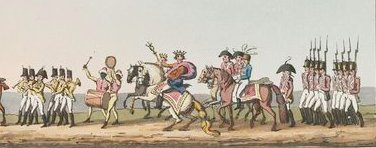This blog has been grievously neglected for several months. Family stuff; my apologies.
The more you look at the uniforms of a particular regiment in this era, the more you appreciate the deviations from the greater uniformity. Where colonels were allowed licence, such as in the clothing of musicians, this is especially so. Drummers are a particular headache, and faced with the arcane and variant complexities of drummers’ lacing, one begins to doubt the detail of many artists’ reconstructions.

Here’s an extremely weird drummer’s cap of the Royal Lancashire Militia from the notebooks of P W Reynolds in the V&A. (Many thanks to Ben Townsend for the photo.) It’s a “Belgic”, or at least a sort of Belgic, attributed to the First Regiment of Lancs Militia around 1814, and Reynolds’s sketch is based on a previous sketch by “JCL”, whoever he or she was – Charles Lyall, maybe?
Reynolds’s assumption is that the cap was of black felt. The front is said to be 9 inches high, so about the norm, but the “pole”, which I understand to mean the cap part, though I’ve never seen that term used elsewhere, is just over 5 inches deep, so more shallow than usual – perhaps scaled down to fit a boy. The front is steeply arched – quite different to the squareish front of the standard Belgic, and so more reminiscent of the shape of the pre-1802 drummer’s fur cap. In place of the usual folding flap at rear is a drum badge, as previously used on the rear of drummers’ fur caps, measuring 2⅛ by 1½ inches and presumably in brass.
The circular plate at front is 3 inches in diameter, again presumably of brass, and Reynolds notes correctly that the elements of the design – “LANCASTER”, rose and wreath – correspond to those of the known Belgic cap plates of the regiment, which are of the standard size and shape. The peak is narrower than the norm at 1½ inches, though that is a feature seen on some officers’ and volunteer caps. JCL had noted that a “festoon” had been worn on the cap and that there was a small hole “in upper part of front”, presumably to take a tuft and cockade, but exactly where was not marked in his sketch.
The cap is said to have been seen at Hawkes’s, the military outfitters. Where is it now? A search of the NAM inventory throws up nothing, though that’s not to be wondered at.
This cap raises all kinds of questions. Why the odd shape, and does it have any relation to drummers’ fur caps or to the tall fronted light infantry caps discussed in this post? Why the small plate when the front was tall enough to take the standard pattern? Does it actually date to circa 1814? Was it a regimental one-off? Or did other regiments adopt similarly mutant forms? And how much can we trust modern illustrations that show drummers of the period wearing the same caps and plates as everyone else?




